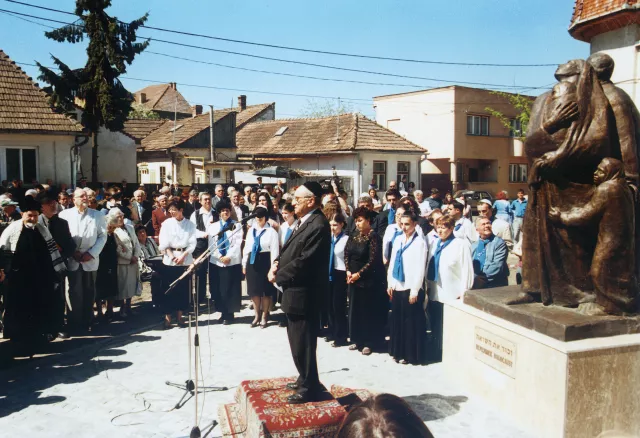This picture was taken in May 2003 in Marosvasarhely, when we inaugurated the statue made by the late sculptor Marton Izsak. [Marton Izsak died in January 2004.] I'm just making my speech here.
With foreign aid and the participation of the locals, and with the large contribution of the Ministry of Culture, we managed to cast the statue in bronze and to erect it. The photo was taken on the occasion of inaugurating the statue, which was attended by residents of Vasarhely, and strangers from Israel or Scotland. The leadership of the Romanian Jewish community was also here, including chief rabbi Menachem Hacohen. The chief rabbi of Temesvar, Erno [or Ernst, rather] Neumann, was also there. He is in this picture on the left. Next to him is one of the delegates from the community from Bucharest, and then Mihaly Spielmann, the head librarian at the Teleki Teka library. The chief rabbi of Scotland, rabbi Weis was here, as well, he is a religious, orthodox rabbi. The delegation had around 20 members who attended the event, they came from Glasgow specially to attend to the inauguration. The group in the back is the choir from Kolozsvar. They sang Hebrew and Yiddish songs, appropriate for the occasion.
The statue is in the center of the city, there's a small park there between the Malom street and the Kossuth street. This was, by the way, one of the Jewish districts before the war, and that's why the statue was put there. It shows a father holding in his arms his mother, his wife with a small child in her lap, and a little girl holding her mother's dress. It represents the father trying to protect his family. They look like they are waiting for help.
In 1982, after I retired, I became the president of the Jewish community from Marosvasarhely. I did not pray and haven't been in a synagogue for more than 30 years. When I got in this position I started over and I everything came back to me. I can't even imagine how I haven't forgotten everything, because when I learned all these things I was 14-15, and I still remembered them at the age of 60. All this time I never said a prayer. Let's say I was an atheist. How did all these things come back to my memory, I don't know. This is a miracle. Everything I knew before, the customs, prayers, what should be said from memory or read on the holidays, the melodies, everything came back to me as if it was pored back in my mind. There were some good chazzanim, but unfortunately they died out. 3 years ago, when Grunstein was still alive, I sat in the synagogue just like any other simple prayer, ony later I got involved in the preface. Now mainly me and dr. Marmor are leading it, and another 87-88 years old man, Lederer, who helps us out now and then. Dr. Marmor, who is two years older than me, and myself lead the prayer, he did it very nicely.
Now I'm conducting the prayer, each Saturday and on the other holidays, as well, for two hours. I know from memory almost three quarters of the ceremony. One time a community members told to another one: 'How can Sauber do this for two hours, him, who was an illegal communist and worked at the public prosecutor's office?' The other ones in the community who know something are Sandor Ausch and Laszlo Grun. (Sandor Ausch and myself were together in captivity. I kept in touch with him when I was still working, and we came together again here at the community.) The service starts each Saturday at 11am and ends at a quarter past 11am. I'm reading every week the Torah, because only dr. Marmor and me can read from it. There is a portion equivalent to some 30 pages to read for each week. The prayer tooks place before and after the reading, which I lead, as well. 15 years ago there were people praying here each morning with tzitzit and tallit. Now everyone uses tallit, but tzitzit only when a rabbi comes here.
Bernat Sauber
The Centropa Collection at USHMM
The Centropa archive has been acquired by the United States Holocaust Memorial Museum in Washington, DC.
USHMM will soon offer a Special Collections page for Centropa.
Academics please note: USHMM can provide you with original language word-for-word transcripts and high resolution photographs. All publications should be credited: "From the Centropa Collection at the United States Memorial Museum in Washington, DC". Please contact collection [at] centropa.org.






